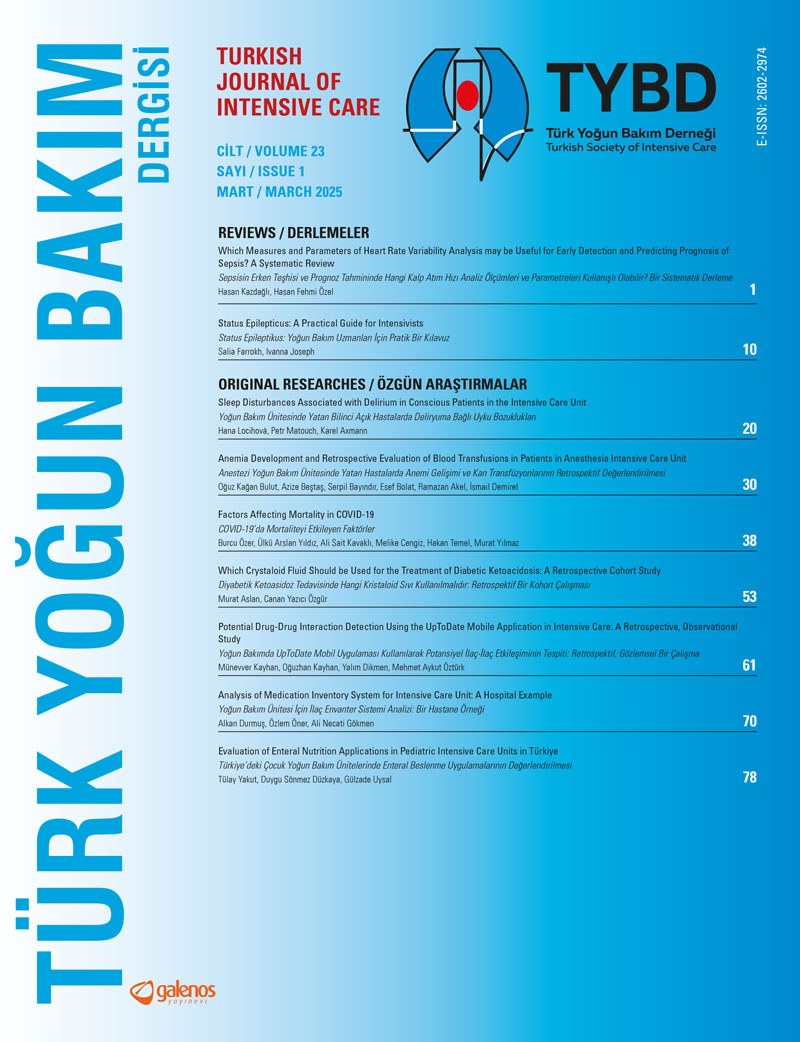Öz
Amaç
Yoğun bakım hastalarında anemi gelişimi sık karşılaşılan bir problemdir. Yoğun bakım kritik hastalarında anemi ve transfüzyon insidansını, transfüzyon ilişkili risklerileri ve klinik sonuçları, tanı ve takip amaçlı alınan kan miktarının anemiye gelişimine katkısını retrospektif olarak araştırmayı amaçladık.
Gereç ve Yöntem
Retrospektif tek merkezli çalışmaya (01.01.2015-31.12.2015) 24 saatten uzun süreli yatan, 18 yaş ve üstü hastalar erkek (Grup E) ve kadın (Grup K) olarak iki gruba ayrılarak karşılaştırıldı. Transfüzyon yapılan ve yapılmayan hastaların ilk 30 günlük hemoglobin (Hb) değerleri, transfüzyon öncesi ve sonrası Hb değerleri, günlük kan kayıpları ve sıvı dengesi, transfüzyon endikasyonları ve ilişkili komplikasyonlar, kullanılan eritrosit süspansiyonu sayıları kaydedildi.
Bulgular
Hastaların yatışın 1. günü %60,7, 3. gününde %83,9’u anemikti. Anemik olmayanların %55,6’sında 3. günde anemi geliştiği saptandı. Hastaların transfüzyon öncesi Hb ortalaması 7,5±1,3 g/dL, transfüzyon sonrası Hb ortalaması 6,9±1,1 g/dL idi. Transfüzyon yapılanlarda akut fizyoloji ve kronik sağlık değerlendirmesi II skorunun daha yüksek olduğu ve bunlardan kadın hastaların mortalitelerinin daha yüksek olduğunu tespit ettik. Yatışın 1. günü ortalama 37,0±15,7 mL/kişi kan örneğinin alındığını; tekrarlayan kan örnekler (ortalama 147,2±117,1 mL) nedeniyle, Hb değerlerinin kan transfüzyonu gerektirecek şekilde anlamlı derecede düştüğünü tespit ettik.
Sonuç
Yoğun bakıma kabul edilen hastaların çoğunluğunun anemik olduğu, zaman içinde Hb değerlerinde düşüş devam ettiği; tekrarlayan kan örneklemlerinin anemi gelişimine katkısı olduğu; transfüzyon ilişkili komplikasyon olarak en sık febril reaksiyon görüldüğü tespit edildi ve mevcut evrensel transfüzyon rehberlerine uygun uygulamalar yapıldığı görüşüne varıldı.
Anahtar Kelimeler: Anemi, kan transfüzyonu, yoğun bakım ünitesi
Referanslar
- Corwin HL, Surgenor SD, Gettinger A. Transfusion practice in the critically ill. Crit Care Med. 2003;31:668-71.
- Lelubre C, Vincent JL. Red blood cell transfusion in the critically ill patient. Ann Intensive Care. 2011;1:43.
- Vincent JL, Baron JF, Reinhart K, Gattinoni L, Thijs L, Webb A, et al. ABC (anemia and blood transfusion in critical care) investigators. Anemia and blood transfusion in critically ill patients. JAMA. 2002;288:1499-507.
- Corwin HL, Parsonnet KC, Gettinger A. RBC transfusion in the ICU. Is there a reason? Chest. 1995;108:767-71.
- Napolitano LM. Scope of the problem: epidemology of anemia and use of blood transfusions in critical care. Critical Care 2004;8:18.
- Carson JL, Hill S, Carless P, Hébert P, Henry D. Transfusion triggers: a systematic review of the literature. Transfus Med Rev. 2002;16:187-99.
- Tinmouth AT, McIntyre LA, Fowler RA. Blood conservation strategies to reduce the need for red blood cell transfusion in critically ill patients. CMAJ. 2008;178:49-57.
- Page C, Retter A, Wyncoll D. Blood conservation devices in critical care: a narrative review. Ann Intensive Care. 2013;3:14.
- World Health Organization. Haemoglobin concentrations for the diagnosis of anaemia and assessment of severity. Vitamin and Mineral Nutrition Information System. Geneva. Access link: https://www.who.int/publications/i/item/WHO-NMH-NHD-MNM-11.1
- Hébert PC, Wells G, Martin C, Tweeddale M, Marshall J, Blajchman M, et al. Variation in red cell transfusion practice in the intensive care unit: a multicentre cohort study. Crit Care. 1999;3:57-63.
- Nguyen BV, Bota DP, Mélot C, Vincent JL. Time course of hemoglobin concentrations in nonbleeding intensive care unit patients. Crit Care Med. 2003;31:406-10.
- Chant C, Wilson G, Friedrich JO. Anemia, transfusion, and phlebotomy practices in critically ill patients with prolonged ICU length of stay: a cohort study. Crit Care. 2006;10:140.
- Rao MP, Boralessa H, Morgan C, Soni N, Goldhill DR, Brett SJ, et al. North thames blood ınterest group. blood component use in critically ill patients. Anaesthesia. 2002;57:530-4.
- Corwin HL, Gettinger A, Pearl RG, Fink MP, Levy MM, Abraham E, et al. The CRIT study: anemia and blood transfusion in the critically ill--current clinical practice in the united states. Crit Care Med. 2004;32:39-52.
- Carson JL, Carless PA, Hebert PC. Transfusion thresholds and other strategies for guiding allogeneic red blood cell transfusion. Cochrane Database Syst Rev. 2016;10:CD002042.
- King KE, Shirey RS, Thoman SK, Bensen-Kennedy D, Tanz WS, Ness PM. Universal leukoreduction decreases the incidence of febrile nonhemolytic transfusion reactions to RBCs. Transfusion. 2004;44:25-9.
- Domen RE, Hoeltge GA. Allergic transfusion reactions: an evaluation of 273 consecutive reactions. Arch Pathol Lab Med. 2003;127:316-20.
- Henry M, Garner W, Fabri P. Iatrogenic anemia. American Journal of Surgery 1986;151:362-63.
- T. Saleh E. Anaemia during critical illness. Br J Anaest. 2006;97:278-91.
- Hajjar LA, Auler Junior JO, Santos L, Galas F. Blood tranfusion in critically ill patients: state of the art. Clinics (Sao Paulo). 2007;62:507-24.
- Vincent JL, Sakr Y, Sprung C, Harboe S, Damas P. Sepsis occurrence in acutely Ill patients (SOAP) investigators. Are blood transfusions associated with greater mortality rates? Results of the sepsis occurrence in acutely Ill patients study. Anesthesiology. 2008;108:31-9.
- Fuller BM, Gajera M, Schorr C, Gerber D, Dellinger RP, Parrillo J, et al. Transfusion of packed red blood cells is not associated with improved central venous oxygen saturation or organ function in patients with septic shock. J Emerg Med. 2012;43:593-8.
- Shapiro MJ, Gettinger A, Corwin HL, Napolitano L, Levy M, Abraham E, et al. Anemia and blood transfusion in trauma patients admitted to the intensive care unit. J Trauma. 2003;55:269-73.
- Leal-Noval SR, Muñoz-Gómez M, Jiménez-Sánchez M, Cayuela A, Leal-Romero M, Puppo-Moreno A, et al. Red blood cell transfusion in non-bleeding critically ill patients with moderate anemia: is there a benefit? Intensive Care Med. 2013;39:445-53.
- Andrews T, Waterman H, Hillier V. Blood gas analysis: A study of blood loss in intensive care. J Adv Nurs. 1999;30:851-57.
Telif hakkı ve lisans
Telif hakkı © 2025 Yazar(lar). Açık erişimli bu makale, orijinal çalışmaya uygun şekilde atıfta bulunulması koşuluyla, herhangi bir ortamda veya formatta sınırsız kullanım, dağıtım ve çoğaltmaya izin veren Creative Commons Attribution License (CC BY) altında dağıtılmıştır.






















